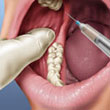Extractions
It's only a tooth - take it out!
This is a common thought among many people, and often that is the best thing to do. If a tooth is grossly decayed, or badly broken down, perhaps even split right through the middle, then extraction is usually the best thing to do.
Some common reasons for the extraction of a tooth are listed:
- badly abcessed
- grossly carious (decayed)
- periodontal (gum) condition so inflamed that the tooth is really loose (mobile)
- split through the centre or side
- little chance of saving the tooth in the long term
- financial considerations
- orthodontic reasons (perhaps there is not enough room in the mouth for all the teeth)
- extreme pain
Remember: Nothing is as good as a natural tooth



The site is numbed with local anesthetic. An elevator may be used to loosen the tooth. Appropriate forceps then remove the tooth.
(pictures courtesy Colgate)
After an extraction - what?
The gum will usually heal up quite quickly after an extraction of a tooth.

(picture courtesy Dr Dan Peterson)
Simple Extraction.
Within a few days the gum will start to heal over, and as time goes by, the gum will become quite firm and hard. Many people are quite happy to leave the gap as it is, without trying to replace the tooth. However, if the gap is conspicuous, or if the person really misses the tooth and has difficulty eating or smiling without the tooth, a replacement needs to be considered.
Partial Denture
This is the simplest way to replace a missing tooth. This is often called a removable bridge.
Bridge
There are various types of bridges, each of which relies on adjacent teeth to support the bridge, which spans the space, or the gap created by the loss of the tooth. For a description of these types of bridges, see the Information section on Bridges on this website.
Implant
An implant may be considered as a replacement for a missing tooth. In our dental office, we refer all implant cases to a specialist. Implants are the best dentistry can offer in the replacement of missing teeth.
Dry Socket
A dry socket can occur when the blood clot does not form properly at the extraction site. If the clot does not form, or if it falls out of the socket, the bone around the edge of the socket will be exposed to the air. This is very painful, and usually starts to show up two to three days after the extraction. When the blood clot stays in place, healing is promoted, and secondary infection is less likely to occur.
When a dry socket occurs, we pack the socket with a product that promotes the healing of the wound, and eases the discomfort. You may need to have that dressing changed once or twice, and you may need to take some antibiotics, but generally a dry socket will heal up without any problems. The quicker that we can get onto treating a dry socket, the faster it will heal. Unfortunately, some people wait for up to two weeks before seeking help, thinking that 'it will get better'.
There are certain factors that can increase the likelihood of a dry socket forming. Smoking, drinking of alcohol or fizzy drinks, or sucking through a straw are all factors in the dry socket formation. Sometimes a dry socket will form for no apparent reason.
Surgical Extractions
Complicated extractions need even more care to ensure that they heal without any troubles. Your surgeon will advise the best course of treatment, which may include having stitches in the wound (to help hold the skin together, so that it can heal more quickly.) Gentle rinsing with warm salty water will help keep the wound clean. However, too vigorous rinsing may dislodge the blood clot, which could lead to a dry socket. Painting the wound with a 1% solution of peroxide will help keep germs at bay that might have entered the wound and caused secondary infection. Your surgeon may also prescribe antibiotics to help eliminate the source of infection.
